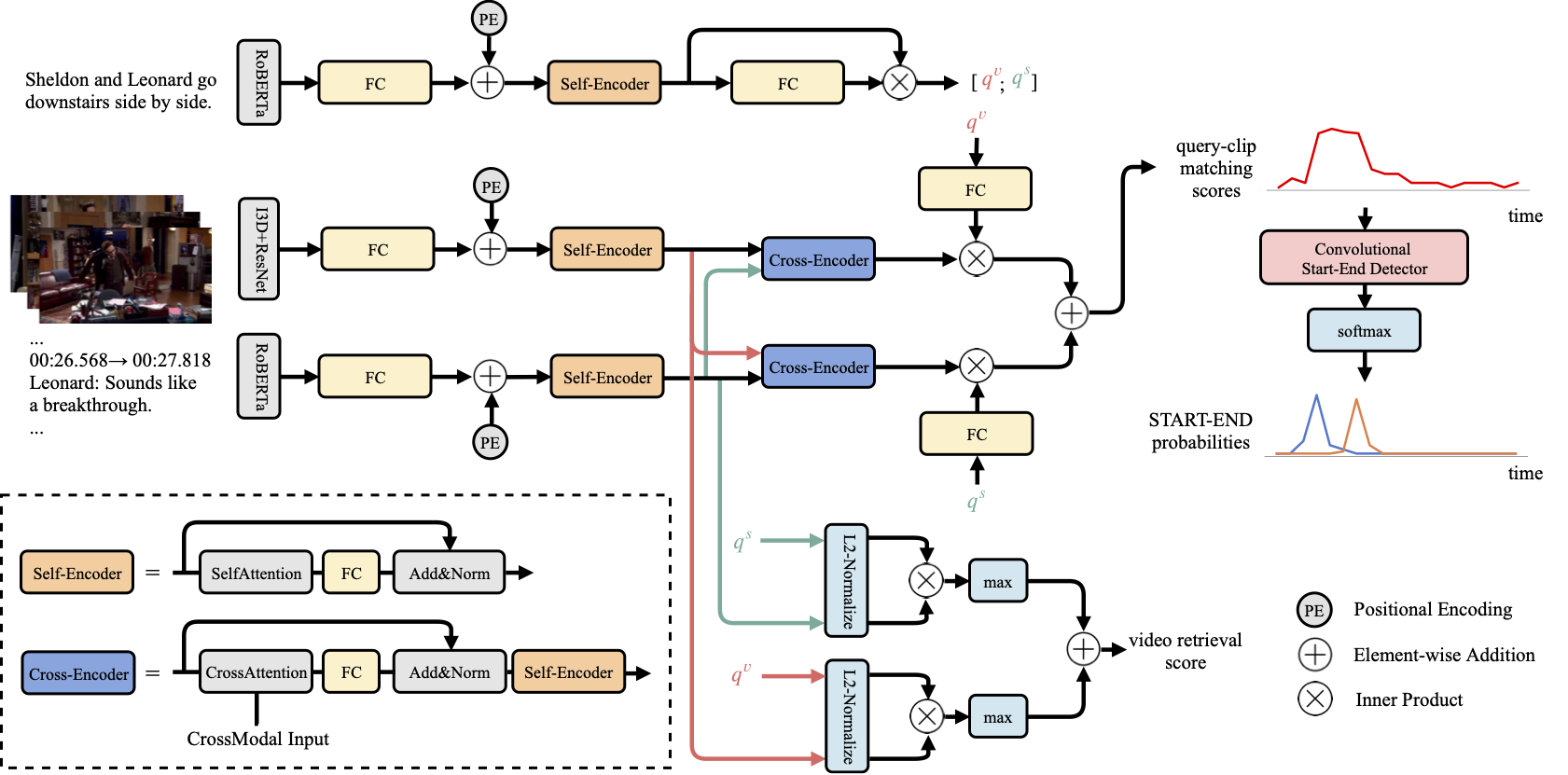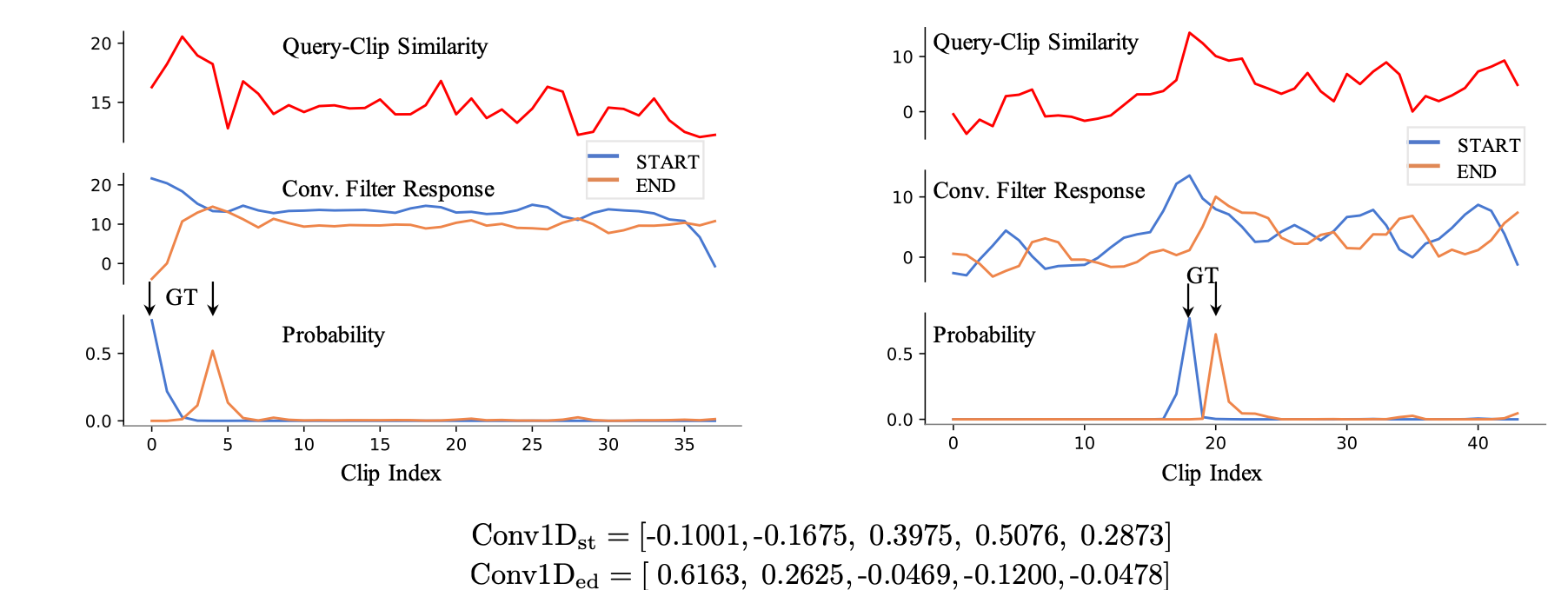TVRetrieval
PyTorch implementation of Cross-modal Moment Localization (XML), an efficient method for video (subtitle) moment localization in corpus level.
TVR: A Large-Scale Dataset for Video-Subtitle Moment Retrieval
Jie Lei, Licheng Yu, Tamara L. Berg, Mohit Bansal
XML achieves high efficiency by applying 1D CNNs on top of query-clip similarity scores,
which is obtained from the inner product of independently modeled query and clip representations.
Such design gets rid of cumbersome early fusion commonly seen in existing moment localization papers
and is thus runs much faster. The learned convolutional filters are also interpretable, where it
gives stronger responses on the left edges (START) and right edges (END) of the similarity
score curve and thus detect them (see figure below). Interestingly, the learned weights
and
,
as shown in the figure, are similar to the edge detectors in image processing.
Resources
- Data: TVR dataset
- Website (with leaderboard): https://tvr.cs.unc.edu/
- Submission: codalab evaluation server
- Related works: TVC, TVQA, TVQA+
Getting started
Prerequisites
- Clone this repository
git clone https://github.com/jayleicn/TVRetrieval.git
cd TVRetrieval
- Prepare feature files
Download tvr_feature_release.tar.gz (33GB).
After downloading the feature file, extract it to the data directory:
tar -xf path/to/tvr_feature_release.tar.gz -C data
You should be able to see tvr_feature_release under data directory.
It contains video features (ResNet, I3D) and text features (subtitle and query, from fine-tuned RoBERTa).
Read the code to learn details on how the features are extracted:
video feature extraction, text feature extraction.
- Install dependencies.
- Python 3.7
- PyTorch 1.4.0
- Cuda 10.1
- tensorboard
- tqdm
- h5py
- easydict
To install the dependencies use conda and pip, you need to have anaconda3 or miniconda3 installed first, then:
conda create --name tvr --file spec-file.txt
conda activate tvr
pip install easydict
- Add project root to
PYTHONPATH
source setup.sh
Note that you need to do this each time you start a new session.
Training and Inference
We give examples on how to perform training and inference for our Cross-modal Moment Localization (XML) model.
- XML training
bash baselines/crossmodal_moment_localization/scripts/train.sh \
tvr CTX_MODE VID_FEAT_TYPE \
--exp_id EXP_ID
CTX_MODE refers to the context (video, sub, tef, etc.) we use.
VID_FEAT_TYPE video feature type (resnet, i3d, resnet_i3d).
EXP_ID is a name string for current run.
Below is an example of training XML with video_sub_tef (video + subtitle + TEF feature),
where video feature is resnet_i3d (ResNet + I3D):
bash baselines/crossmodal_moment_localization/scripts/train.sh \
tvr video_sub_tef resnet_i3d \
--exp_id test_run
This code will load all the data (~60GB) into RAM to speed up training,
use --no_core_driver to disable this behavior. You can also use --debug before actually training the model to
test your configuration.
By default, the model is trained with all the losses, including
video retrieval loss
and moment localization loss
.
To train it for only the moment localization, append
--lw_neg_q 0 --lw_neg_ctx 0.
To train it for only video retrieval, append --lw_st_ed 0.
Training using the above config will stop at around epoch 60, around 4 hours on a single 2080Ti GPU server.
You should get ~2.6 for VCMR R@1, IoU=0.7 on val set.
The resulting model and config will be saved at a dir:
baselines/crossmodal_moment_localization/results/tvr-video_sub_tef-test_run-*.
- XML inference
After training, you can inference using the saved model on val or test_public set:
bash baselines/crossmodal_moment_localization/scripts/inference.sh MODEL_DIR_NAME SPLIT_NAME
MODEL_DIR_NAME is the name of the dir containing the saved model,
e.g., tvr-video_sub_tef-test_run-*.
SPLIT_NAME could be val or test_public.
By default, this code evaluates all the 3 tasks (VCMR, SVMR, VR), you can change this behavior
by appending option, e.g. --tasks VCMR VR where only VCMR and VR are evaluated.
The generated predictions will be saved at the same dir as the model, you can evaluate the predictions
by following the instructions here Evaluation and Submission.
Except for XML model, we also provide our implementation of CAL, ExCL and MEE. Their training, inference and evaluation is similar to XML.
Evaluation and Submission
Citations
If you find this code useful for your research, please cite our paper:
@inproceedings{lei2020tvr,
title={TVR: A Large-Scale Dataset for Video-Subtitle Moment Retrieval},
author={Lei, Jie and Yu, Licheng and Berg, Tamara L and Bansal, Mohit},
booktitle={Tech Report},
year={2020}
}
Acknowledgement
This research is supported by NSF Awards #1633295, 1562098, 1405822, DARPA MCS Grant #N66001-19-2-4031, DARPA KAIROS Grant #FA8750-19-2-1004, Google Focused Research Award, and ARO-YIP Award #W911NF-18-1-0336.
This code is partly inspired by the following projects: transformers, TVQAplus, TVQA.
Contact
jielei [at] cs.unc.edu

